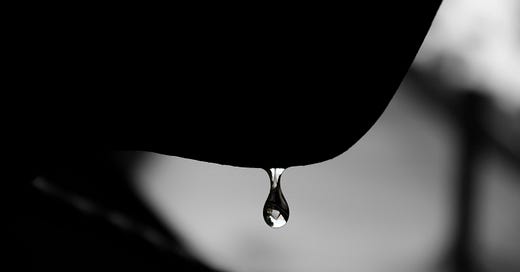Science Shows Tears Are More than An Emotional Release
Researchers discovered the scent of a female's tears decrease aggression in males
Hiya!
We often associate crying with emotions like sadness and sometimes joy, and many assume Humans are the only animals to do so. Yet the truth is, we shed tears for more than emotional reasons. We also aren’t the only animals to get teary-eyed. In fact, many animals do. Now, science has discovered another effect of our water-works.
A new study conducted by some very determined researchers identified a biological reason for crying that extends beyond emotional release or seeking compassion. They found that emotional female tears are also stealthy chemical peacemakers that measurably decrease male aggression. However, the team believes future research may show the effect extends beyond biological sex.
Animals Shed Tears Too
As I mentioned, producing tears has long been considered a uniquely Human trait. But, surprise, surprise, this assumption is a “flawed notion,” according to Noam Sobel, a neurobiologist at the Weizmann Institute of Science and co-senior author of the study I’ll tell you about soon.
The truth is, many animals produce tears for all sorts of reasons. For instance, both female and baby mice shed tears, but for different purposes. The pheromones in female mice’s tears motivate male mice to cease fighting each other and mate with the crying female instead. Meanwhile, the tears shed by baby mice have molecular signals that persuade female mice to reject male advances.
Inferior mole rats are especially dramatic criers that will cover themselves with their tears, which chemically deflect aggression from more dominant members. But the most heartwarming example is the tears dogs shed while reuniting with their owners after being separated.
There are several more examples I could share, but I think you get the point. So let’s move on.
Types of Tears
If I’m honest, I never thought about tears much before, but I suppose I assumed that all tears are created equal and made of the same stuff — saline. But it turns out my assumption was flawed, too.
In actuality, tears are made of more than saline alone. They also contain electrolytes, enzymes, lipids, and metabolites — similar to saliva. Each tear has three layers, which, according to the American Academy of Ophthalmology, are:
The outer layer of a tear has an oily surface to keep the tear’s surface smooth so we can see through it. The oil also prevents the other layers from evaporating.
The middle and thickest layer of a tear is watery to keep hydrated, protect the cornea, and repel bacteria.
Lastly, the innermost layer is mostly mucus that keeps the whole tear connected to the eye.
In addition to the three layers, our bodies create three types of tears.
Basal tears are always in our eyes because they lubricate our eyeballs while nourishing and protecting our corneas. These tears shield our eyes from harmful dirt and debris, which can cause damage.
Reflex tears form to wash away irritants, such as dirt, smoke, or onion fumes, when they breach the basal tear shield. These tears are larger than basal tears and can include antibodies to help fight bacteria.
Emotional tears are the ones we typically think of, which form in response to various emotions, including sadness, fear, joy, and more. Some scientists, including the ones I’ll tell you about next, theorized that emotional tears include hormones and proteins that basal and reflex tears do not.
Well, the new research found evidence to back up the theory and show how powerful they can be.
Keep reading with a 7-day free trial
Subscribe to Curious Adventure to keep reading this post and get 7 days of free access to the full post archives.



